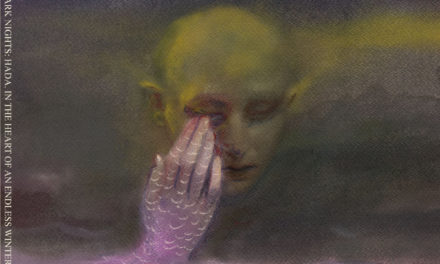Rome
Die Æsthetik der Herrschaftsfreiheit
Trisol, 2011
Jerome Reuter has been besting the Old Gods of neo-folk at their own game for a while, releasing arguably the best records in the genre for half a decade. Now, he’s doubled-down by fulfilling the one great trope which unites all neo-folk acts: the extravagant multi-CD box set. After recording five albums as Rome, he’s well due to re-release a couple of them (bundled with a third CD of “acoustic reinterpretations”, ignoring just how acoustic the originals already were) in a lavish box which’ll force die-hard fans to shell out again for stuff they already have. Only problem is, Reuter apparently doesn’t understand the formula: instead of repackaging his old stuff, he’s recorded Die Æsthetik der Herrschaftsfreiheit, a triple-album of new material. Count each disc in the set as an individual LP (they’re due to be released as such in the new year) and that makes for eight albums in six years, plus several EPs. It’s almost as if he’s more interested in developing as a songwriter rather than fleecing his (devoted) fanbase. But there’s much more at play in Die Æsthetik than good contemporary neo-folk. If this review comes across as lengthy yet incomplete, it’s because this album aligns itself with dialectic traditions of art and philosophy which simultaneously demand “a ruthless criticism of everything” and oppose the suturing off of discussion through reductive summarization. Apologies in advance…
Die Æsthetik is both Reuter’s most political album and the one most concerned with art, and it’s worth talking about how those concepts operate in relation to his work as a whole. Reuter’s a relatively unique bird when it comes to leftist songwriters. Rather than deploying a panoply of didactic messages on a variety of topics (the approach often favoured by crust-punk and politically-minded industrial artists, among others) or even attempting to demonstrate the inseparability of the personal and the political (as with Billy Bragg and, to some extent, Bruce Springsteen), Reuter’s focus is the tension between the specific and the general, the lived and the mythic. While Reuter’s songs are rife with maxims, ideals and utopian dreams, as I’ve written before these never eclipse the individual and the suffering to which they are all too often subjected. Rome’s songs tread the line between canonizing the recurring material conditions of the fight against oppression as unassailable myth and attending to the specificities of individual fights and fighters.
Art is the catalyst for this tension between the particular and the idealized: “Art holds a unity that history does not” is one of the mottoes of Die Æsthetik der Herrschaftsfreiheit. While other neo-folk acts might interpret this phrase as a justification for escapism, for using art as a blanket excuse for claiming that their (inescapably political) work is apolitical, Reuter instead has taken it as a challenge, an invitation to frame the historical referents he chooses for his work as cohesively and honorably as is possible. This mission has reached its apotheosis in Die Æsthetik der Herrschaftsfreiheit. The title is the first clue. A play on the title of Peter Weiss’ Die Ästhetik des Widerstands, it translates roughly as “The Aesthetics of Freedom-From-Domination” (though “domination” might be a bit dodgy – “Herrschaft” alone is already one of those wonderful German compound words which can’t be broken down and translated into English without destroying its multiplicity of meaning). In addition to sharing with Weiss’ novel an interest in the locus of art and politics, the album is similarly divided into three separate volumes – Aufbruch: A Cross Of Wheat, Aufruhr: A Cross Of Fire, and Aufgabe: A Cross Of Flowers. Translating the titles of these volumes (Departure, Turmoil, Duty) hints at a narrative – the flight from tyranny, a conflict with it, and the responsibility to create a better world in its wake – but all of these drives and instances could just as easily be occurring simultaneously.
Despite the thematic titling of each volume, Die Æsthetik functions perfectly well as a continuous whole rather than as a group of distinct, compartmentalized components. While further playthroughs may yield subtler threads of internal cohesion, I found the themes of each volume to be best taken as loose guidelines rather than strict boundaries of import; Aufbruch is the most bitter, Aufruhr the most romantic and bombastic, Aufgabe the most contemplative.
An early comment from Reuter hinted that the sound of Die Æsthetik might be closer to his early Cold Meat Industry records, like Berlin and Nera than his more recent records. While there is certainly plenty of his formative cold, industrial grind found on these discs (“The Angry Brigade”, “Our Holy Rue”), there’s also lots of the more colourful folk balladeering of newer work like Nos Chants Perdus and Flowers From Exile (which respectively dealt with the French Resistance and the Spanish Civil War). Happily, he’s found a way to improve the latter category – while I was pleased to hear Reuter moving in new musical directions, I found that he hadn’t quite wedded his keen ear for songcraft with these newer forms. On Die Æsthetik, such songs are the undisputed highlights, with subtle keyboard and accordion textures lending warmth to the acoustic strumming of songs like “Dawn And The Darkest Hour”. When this formula is applied to lyrics as resonant as those of “Seeds Of Liberation”, the resulting clarion call is nothing short of transcendent.
Those new to Rome might find the prospect of a triple album steeped in military history which uses the speeches of Proudhon as interludes to be somewhat imposing, but they’re soon to discover what’s been apparent since 2007’s Confessions D’Un Voleur D’Ames; that Reuter, perhaps more than any other neo-folk artist ever, has been able to align that genre’s “secret history of Europe” with the not-so-secret history of twentieth century pop. Rome’s music is as indebted to Jacques Brel’s as much as it is Douglas P’s. Songs like “Little Rebel Mine” and “The Breaking Part” call to mind names renowned for subtleties of warmth and polish as well as the gravity of their work: Scott Walker, John Cale, Gavin Friday, Nick Cave. I’ve always resisted comparing Reuter to Leonard Cohen as others have done (Reuter could surely perform “The Partisan” or “Who By Fire” with aplomb, but I imagine he’d blanch at “Hallelujah” or “Famous Blue Raincoat”), but Die Æsthetik‘s range of instrumentation shows at least one commonality between the two – a near instant recognition of their songs, regardless of presentation. There’s simply no one else writing stuff of Reuter’s caliber right now. As I mentioned at the outset, we’re just damn lucky he hasn’t taken that as a cue to rest on his laurels.
It isn’t just the music of Die Æsthetik which is indicative of attention to both quality and the album’s overarching concept. The album’s stated intent of finding commonality between struggles against tyranny (like the aforementioned French and Spanish ones) is offset by the heterogeneity of historical referents found in its songs, and the distinctly personal moods of its love songs and narratives (again, the balance of generalities and specifics); a similar relationship can be found in its presentation. The three books in which the individual records are housed are full of photos of partisans and resistance fighters. Bereft of context (no information is giving locating these photos in history), these individuals’ fights are subsumed within the broad category of anti-fascist action, yet in the specific selection of photos we see living, breathing people rather than stock historical figures. Men and women hold mandolins, flutes, and accordions as well as rifles, smile and embrace each other rather than stare blankly at the camera in uniform stoicism. What is signified is that these struggles are predicated not on abstract political theory or blind patriotism, but on the unique loves and lives of each person depicted. A solidarity which celebrates the individual above all else might sound like a paradox or an untenable political platform, but it is just such a position that art affords, and Reuter is well aware of this.
These are not simply songs of resistance, they are songs of resistance about songs of resistance. That distinction might sound like a cheap postmodern parlour trick, but it’s a crucial distinction in the context of neo-folk, a genre which often trades in the fallacy of nostalgia at best and repackages the injustices of the past wholesale at worst. To acknowledge aesthetics is to eschew reductive essentialisms and to begin to investigate the foundations of one’s taste, and ergo beliefs. It’s no coincidence that Reuter cites Brecht as an influence in Die Æsthetik‘s liner notes; as Brecht, perhaps the twentieth century’s greatest political artist famously observed, “art is not a mirror held up to reality, but a hammer with which to shape it.”







i don’t pretend to “get” everything stated in your review but i do get this much: rome (as the artist) is absolutely striking and breath-taking, regardless of politics. in fact, i enjoy all of these albums *apart* from the quite obvious political elements. as expressions of human emotion and fragility, these are, as you might say, par excellence. suddenly, rome is in my top 20 or so list of musical artist all-time. and probably the only neo-folk entry. not that i know that much about neo-folk. or care. this is quite simply amazing music. and i would guess mr. reuter would embrace the just comparison to mr. cohen.
It’s absolutely breathtaking stuff, and definitely seems to be finding an audience outside of the usual neo-folk niches (as it well deserves). Thanks for the comment, Patrick!
…And your e-mail address is spot on: Maiden does, indeed, friggin’ rule. 🙂
This might be a bit late (given this review is over 2 years old), but Aufgabe has an other translation: capitulation. I never read Aufgabe as duty, but it makes sense. “appel to the slaves” sugests a duty for the future.
Interesting, thanks very much! These sorts of subtleties within German are partly why I’m so consistently flummoxed by Heidegger and Hegel (though “capitulation to the slaves” certainly jibes with Hegel).
Even later (7 years after the original post), another remark: I’d translate Herrschaftsfreiheit as Freedom from Sovereignity. Apparently the scientific English term is an acephalous society but I’m not sure how much this is used in everyday language.